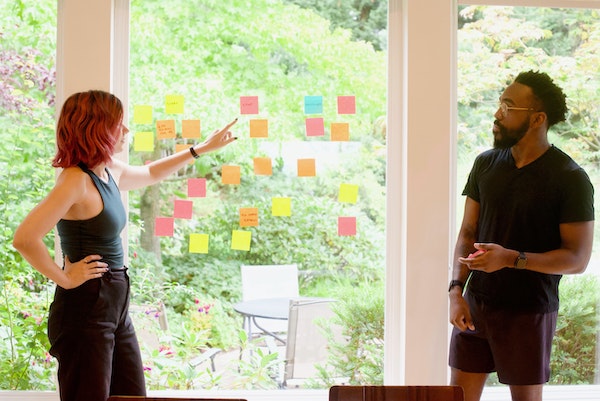If you want to be successful in any field, you need to know how to generate good ideas. And brainstorming is an essential skill for coming up with new and innovative concepts.
It's how we're able to ask ourselves the right questions. It's how we're able to problem-solve effectively . It's how we can efficiently get to the best possible solution, no matter what we're working on.

When it comes to brainstorming, there is no one-size-fits-all approach. In fact, there are a variety of different techniques that can be used! Of course, the best way to brainstorm depends on the situation and the type of problem you're trying to solve, but here are some general principles that can help make your brainstorming sessions that much more effective:
1. Mind Mapping
Mind mapping is a technique that allows you to visually organize your thoughts and ideas. This technique involves creating a diagram with your main idea in the center and then drawing branches out from that central point with related ideas.
This method is great for seeing the big picture and making connections between different concepts. It can also help you to come up with new ideas by sparking creativity. You can add details and notes to each branch as needed. So be creative with your mind map – use colors, images, and whatever else will help you to better visualize your thoughts.
2. Starbursting
Starbursting is another helpful visual brainstorming technique. With this method, you start with a central question or problem and then “burst out” with a series of related questions so that you can explore it from all angles.
Many start with the basics: Who? What? When? Where? Why? And How? This can be done by asking yourself questions such as:
- What would happen if…?
- How could I turn this problem into an opportunity?
- What are some alternative uses for this product/service?
With this method, you're able to generate lots of ideas very quickly to help you move on to your next stage in the brainstorming process.
3. SCAMPER
SCAMPER is an acronym that stands for Substitute, Combine, Adapt, Modify, Put to other uses, Eliminate, and Reverse. This technique is all about taking an existing product or idea and thinking of ways to improve it.

Simply take the problem or issue you're trying to solve, and then ask yourself how you could substitute something else for it, combine it with something else, adapt it in some way, put it to another use, eliminate it, or reverse it.
Here's a quick example:
Let's say you're trying to come up with new ideas for a fitness app. You could ask yourself the following questions using SCAMPER:
- Could we substitute a different type of exercise?
- What if we combined this app with a healthy eating app?
- What if we adapted the app to be used by seniors or people with disabilities?
- Could we put the app to another use entirely, like using it to help people quit smoking?
- What if we eliminated some of the features that are currently included?
- Would reversing the order of the exercises make it more effective?
This brainstorming method helps you to generate new ideas by looking at a concept in a different way which is great for coming up with creative solutions.
4. Rapid Ideation
And then there's Rapid ideation. This is a technique that involves generating a large number of ideas in a short period. The goal is to come up with as many ideas as possible without judging or evaluating them.
This method is great for getting the creative juices flowing and thinking outside the box, especially if you're experiencing a creative block. To do this:
- Set a timer for 5-10 minutes and start brainstorming.
- Write down every single idea that comes to mind, no matter how crazy or far-fetched it may seem.
- Once the time is up, go through your list and start refining and expanding on the ideas that you think have potential.
5. Brainstorming with Others
Brainstorming with a group can be very effective in coming up with new ideas. This technique allows you to bounce ideas off of others and get direct feedback and input.

By brainstorming with a group, you can get different perspectives on an issue and help to stimulate new ideas. It's important to make sure that everyone feels comfortable sharing their ideas and that there is no judgment or criticism of them. The goal here is to take advantage of the variety of perspectives in the room to generate as many new ideas as possible.
6. Reverse Brainstorming
Reverse brainstorming is a unique approach to problem-solving. With this method, you start by identifying the desired outcome and then work backward to come up with ways to achieve it.
This method is a technique that's often used when you're stuck on a problem. So to use it, start by identifying the goal or outcome that you want to achieve. Once you have a clear idea of what you're trying to accomplish, start brainstorming all the ways that you could achieve it. Don't worry about whether or not the solutions are realistic, just let your mind run wild.
Once you have a long list of potential solutions, start evaluating them and eliminating the ones that wouldn't work. This can help you narrow down your options and come up with a few realistic solutions to try. Plus, it can help you think of creative solutions that you might not have otherwise considered.
7. Creative Constraints
Adding constraints to your brainstorming can help you be more creative. This technique involves setting limits on what can be done to force yourself to think outside the box.
For example, let's say you're trying to develop a new product idea. You could set a constraint that it has to be something that can be made for under $10. This would force you to get creative and come up with an innovative solution that meets the price point.
Other brainstorming constraints can include things like time limits, material limitations, or even location. The key is to set parameters that will challenge you to be creative in your thinking.
The goal here is to push yourself to develop creative solutions within the given constraints to stimulate new and innovative ideas.
So by using these brainstorming techniques, you'll be able to generate a large number of ideas very quickly. And with practice, you'll get better and better at coming up with great ideas. So don't be afraid to experiment with different techniques and see what works best for you.
Because you see, brainstorming is more than just coming up with ideas – it's an essential skill for anyone who wants to be successful. By learning how to brainstorm effectively, you'll be able to come up with the best ideas and solve problems more efficiently.
And while you're here, I want to share with you something very special. It's regarding you and your manifesting ability. And the reason I bring it up is that so many of my students are always coming to me with questions on how they can amplify their manifesting power. And I think I have figured out a little solution that I think you're going to love!
This is why I bring you the Manifest Miracles Power Pack - it's a set of guided meditations specially engineered to level up your manifestation power and personal abundance energy... one meditation at a time. It's a very special program that includes a unique set of 5 meditations, each to be used at different times of the day, activating different states of mind you may find yourself in. It's really powerful stuff, so get ready to witness miracles as you've never seen! Go here now to claim your special discount and prepare to unleash your ultimate creation power !








